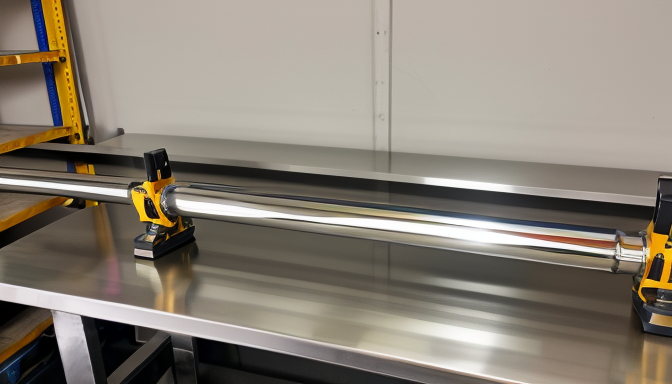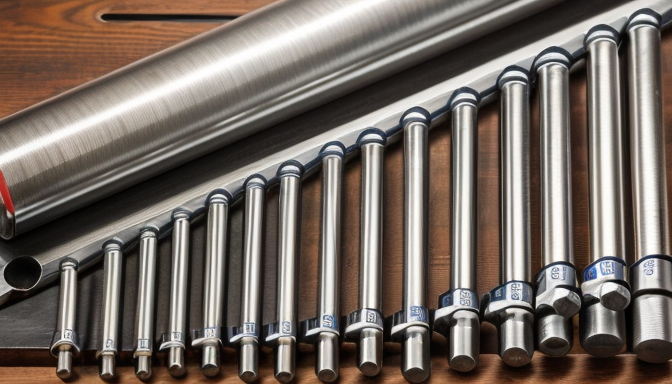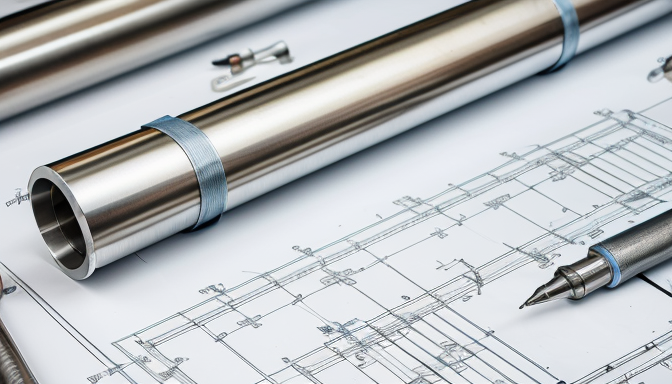When you think of stainless steel pipes, what comes to mind? Maybe it’s their shiny surface or their sturdy feel. These pipes are more than just a pretty face; they play a crucial role in various industries. From plumbing to construction, they are everywhere! But what makes them so special? Let’s dive into the world of stainless steel pipes and uncover their secrets.
First off, let’s talk about why people choose stainless steel pipes. One reason is their durability. Unlike other materials, stainless steel can withstand harsh conditions. It’s resistant to rust and corrosion, which means it lasts longer. Imagine having a pipe that doesn’t give in to the elements. That’s the magic of stainless steel!
Another factor is versatility. These pipes come in different sizes and grades, making them suitable for various applications. Whether you need a small pipe for a home project or a large one for industrial use, there’s a stainless steel pipe that fits the bill. It’s like having a toolbox where every tool is just right for the job.
But let’s not forget about the environment. Stainless steel is recyclable. This means when a pipe reaches the end of its life, it can be melted down and reused. This is a win-win for both the economy and the planet. By choosing stainless steel, you’re making an eco-friendly choice.
Now, you might be wondering about the price of these pipes. Understanding the pricing factors is essential for budgeting. Prices can vary based on several things, including:
- The grade of stainless steel
- The size of the pipe
- Market trends
Knowing these factors can help you make informed decisions when purchasing stainless steel pipes.
In conclusion, stainless steel pipes are an essential material in today’s world. Their durability, versatility, and eco-friendliness make them a top choice for many applications. Whether you’re a homeowner or a contractor, understanding these pipes can help you choose the right one for your needs. So, the next time you see a shiny stainless steel pipe, remember all the hard work it does behind the scenes!
Stainless Steel Pipe Price
Understanding the pricing factors for stainless steel pipes is crucial for budgeting and procurement. The cost of these pipes can vary widely based on several elements. For instance, the grade of stainless steel used plays a significant role in determining the price. Higher grades, such as 316, are more expensive due to their increased corrosion resistance and durability. On the other hand, lower grades like 304 are more affordable but may not be suitable for all applications.
Market trends also influence prices. When demand spikes, so do costs. For example, during construction booms, the price of stainless steel pipes often rises. It’s essential to keep an eye on these trends if you’re planning a project. Additionally, the size of the pipe affects the price. Larger diameters typically cost more due to the increased amount of material required.
To give you a clearer picture, here’s a simple breakdown of how size and grade can affect the pricing:
| Pipe Size (inches) | Grade 304 Price (per foot) | Grade 316 Price (per foot) |
|---|---|---|
| 1 | $3.00 | $4.00 |
| 2 | $6.00 | $8.00 |
| 3 | $9.00 | $12.00 |
When considering the overall cost, don’t forget about additional expenses. These might include transportation, taxes, and installation fees. It’s not just about the price tag on the pipe itself. For instance, if you’re buying locally, you might save on shipping costs. Conversely, ordering from a distant supplier could add a significant amount to your total.
In conclusion, when budgeting for stainless steel pipes, think about all these factors. Keep an eye on market trends, choose the right grade, and consider the size. By doing so, you’ll be better equipped to make informed decisions that fit your project’s needs.

Stainless Steel Pipe Weight
The weight of stainless steel pipes is a key factor for anyone involved in construction or manufacturing. Why? Because understanding the weight helps with transportation, installation, and overall project planning. Imagine trying to lift a heavy pipe without knowing its weight. It could lead to accidents or delays, right? So, let’s dive into this topic!
First off, the weight of a stainless steel pipe varies based on its size and grade. Different sizes mean different diameters and wall thicknesses, which directly affect the weight. For instance, a small pipe might weigh just a few pounds, while a larger one could tip the scales at hundreds of pounds. Here’s a quick breakdown for better understanding:
| Pipe Size (inches) | Weight (lbs per foot) |
|---|---|
| 1/2 | 0.84 |
| 1 | 2.27 |
| 2 | 5.00 |
| 3 | 9.07 |
As you can see, the weight increases significantly with size. This is crucial when planning how many pipes can fit in a truck or how many workers are needed for installation. But wait, there’s more! The grade of stainless steel also plays a role. Higher grades often mean thicker walls, which adds to the weight. So, when choosing pipes, you need to balance between strength and manageability.
Another important aspect is the material density. Stainless steel has a density of about 0.290 lbs/in³. This means that if you have a pipe that is 1 inch in diameter and 1 foot long, you can easily calculate its weight. It’s like doing a little math puzzle! Here’s how you can do it:
Weight (lbs) Volume (in³) × Density (lbs/in³)Volume of a cylinder π × (radius²) × height
So, if you know the dimensions of your pipe, you can quickly figure out its weight. This can save you time and headaches down the line. Understanding the weight of stainless steel pipes is not just about numbers; it’s about making informed decisions that affect your entire project. Whether you’re ordering materials or planning logistics, this knowledge is essential.
In conclusion, when considering stainless steel pipes, don’t overlook their weight. It’s a simple yet crucial detail that can impact your project significantly. So next time you’re at the hardware store or reviewing specifications, keep this in mind. It could make all the difference!
Stainless Steel Pipe Properties
When it comes to stainless steel pipes, the properties are what truly set them apart. Imagine a material that can withstand harsh conditions while maintaining its integrity. That’s what you get with stainless steel. These pipes are not just any ordinary pipes; they are designed to last. Their corrosion resistance is one of their standout features. This means they can handle moisture and chemicals without succumbing to rust. You might wonder, how does that impact you? Well, if you’re using these pipes in a plumbing system or an industrial setting, you can count on them to perform reliably over time.
Another remarkable property is durability. Stainless steel pipes are tough. They can endure high pressures and extreme temperatures. Think of them as the superheroes of the piping world. Whether it’s hot steam or freezing cold water, these pipes can handle it. This makes them ideal for a variety of applications, from residential plumbing to large-scale industrial projects. You won’t have to worry about frequent replacements or repairs.
Temperature tolerance is another key aspect. Stainless steel pipes can function effectively in a wide range of temperatures. This property is essential for industries like oil and gas, where pipes are exposed to extreme heat and cold. If you’ve ever had to deal with a burst pipe in winter, you know how important it is to choose materials that won’t fail under pressure.
Let’s not forget about the aesthetic appeal. Stainless steel pipes have a shiny, sleek finish that can enhance the look of any installation. Whether you’re using them for visible plumbing or structural support, they add a touch of elegance. Plus, they’re easy to clean and maintain, which is a bonus for anyone who values appearance.
Here’s a quick overview of some key properties of stainless steel pipes:
| Property | Description |
|---|---|
| Corrosion Resistance | Resists rust and chemical damage |
| Durability | Long-lasting and tough against wear |
| Temperature Tolerance | Effective in extreme heat and cold |
| Aesthetic Appeal | Shiny finish adds elegance |
In summary, the properties of stainless steel pipes make them a top choice for many applications. Their ability to resist corrosion, withstand pressure, and maintain appearance is unmatched. If you’re considering a project that requires reliable piping, stainless steel should be at the top of your list. It’s not just about pipes; it’s about investing in quality and longevity.

Stainless Steel Pipe Sizes
When it comes to stainless steel pipes, size matters. Choosing the right size is crucial for ensuring that your project runs smoothly. Imagine trying to fit a square peg in a round hole; that’s what it feels like when you select the wrong pipe size. So, what are the standard sizes available?
Stainless steel pipes are typically measured by their nominal pipe size (NPS), which is a standardized designation. This means that you’ll often see sizes like 1 inch, 2 inches, and so on. But don’t be fooled! The actual diameter can vary. For example, a 1-inch pipe might have an outer diameter of about 1.315 inches. It’s important to pay attention to these details.
| Nominal Pipe Size (NPS) | Outer Diameter (OD) in Inches | Wall Thickness (Schedule 40) |
|---|---|---|
| 1 | 1.315 | 0.133 |
| 2 | 2.375 | 0.154 |
| 3 | 3.500 | 0.216 |
| 4 | 4.500 | 0.237 |
Different applications require different sizes. For instance, if you’re working on plumbing, you might need smaller pipes, while industrial applications often call for larger diameters. It’s like choosing the right tool for a job; the wrong size can lead to leaks or even structural failures. So, how do you decide?
Here are a few tips to help you choose the right size:
- Consider the flow rate: Larger pipes can carry more fluid, but they also take up more space.
- Think about the application: Are you using it for water, gas, or something else? Each has its own requirements.
- Check local codes: Sometimes, regulations dictate the size you must use.
In summary, understanding the sizes of stainless steel pipes is essential for any project. Whether you’re a DIY enthusiast or a seasoned professional, knowing the right dimensions can save you time and money. So, before you make a purchase, take a moment to consider what you really need. It’s all about making informed choices!
Frequently Asked Questions
- What are the main uses of stainless steel pipes?
Stainless steel pipes are incredibly versatile! They are commonly used in industries such as construction, plumbing, and manufacturing. Their resistance to corrosion and high temperatures makes them ideal for transporting water, gas, and even chemicals. Think of them as the superheroes of piping materials!
- How does the price of stainless steel pipes vary?
The price of stainless steel pipes can fluctuate based on several factors, including the grade of stainless steel, market demand, and the size of the pipe. For instance, higher-grade stainless steel, which offers better corrosion resistance, typically costs more. It’s like shopping for a car; the features you want will impact the price!
- How do I determine the right size of stainless steel pipe for my project?
Choosing the right size is crucial! You’ll want to consider the flow rate and pressure requirements of your system. Standard sizes are available, but sometimes a custom size might be necessary. It’s a bit like finding the perfect pair of shoes; you want them to fit just right!
- What properties make stainless steel pipes a good choice?
Stainless steel pipes are known for their corrosion resistance, durability, and ability to withstand high temperatures. These properties ensure they last longer than other materials, making them a cost-effective choice in the long run. Imagine investing in a durable backpack that can withstand all your adventures!
- What factors affect the weight of stainless steel pipes?
The weight of stainless steel pipes is influenced by their diameter and wall thickness. Larger diameter pipes with thicker walls will naturally weigh more. It’s like comparing a lightweight jacket to a heavy winter coat; size and material make a big difference!
